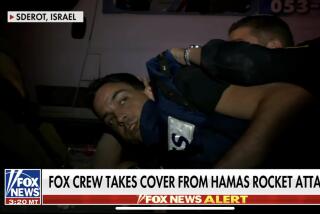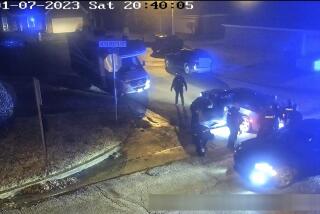An Ooops! on Live TV
- Share via
It’s happening, it’s now, it’s live.
We watched democracy gasp and gurgle in Tien An Men Square, live. We watched the Berlin Wall being razed, live. We watched the Soviet Union unravel, live. Recently we watched parts of Los Angeles explode, live. And on the screen last Friday, there was Los Angeles Police Chief Daryl F. Gates addressing criticism of his department’s performance during the riot, live.
Thus, live television is always valid. It’s always glorious and necessary. It’s always preferable to videotaped television.
Not.
It’s last Monday. You’re on television being interviewed about riot coverage, and you’re rolling along, really cooking. You’ve never been more eloquent. Your words form sentences that express thoughts that blend together as perfectly as a Matisse. You’re magnificent. You’re the prince of the airwaves. You’re thinking that you deserve your own show.
And then. . . .
Your house of cards collapses. The interviewer asks you a final question, and as soon as you answer it--a millisecond after the last word has been launched from your lips--you know you’ve made a terrible mistake. Addressing a highly sensitive topic, you didn’t say what you intended to say.
This time, Mr. Writer, there are no safety nets. There is no computer “delete” key to erase your error. There is no editor to rescue you. Nor are your comments a yo-yo that you can yank back. It’s too late. You’re history, bumped from the screen by a commercial, betrayed by your own inability to communicate verbally.
And by live TV.
This scenario happened to tongue-tangled yours truly at approximately 5:20 a.m. on “CBS This Morning,” which airs here on a three-hour delay but which is seen live in the East. Responding to a question by co-host Paula Zahn (who was doing the interview by satellite from New York), I urged TV to provide more balanced coverage of minorities. Very nice. But I also said that TV pictures of the Los Angeles riots “affirmed the ‘Gorillas in the Mist’ image that many think underlied (sic) the Rodney King incident in the first place.”
Affirmed? The image?
Ooops.
I couldn’t blame Zahn or television or “CBS This Morning.” The fault was all mine. I had been informed what area Zahn’s questions would cover and had formulated my spontaneous, brilliant answers. I had intended to say that the TV pictures “reinforced the inaccurate and unfair ‘Gorillas in the Mist’ stereotype” that many believe motivated the King beating. Not too shabby.
But what my brain was saying, my tongue was disobeying. As a result, one could infer from the response that I gave that I endorsed the very ugly stereotype I meant to criticize. Some people did infer that.
Immediately after my segment aired in Los Angeles, for example, a woman identifying herself as African American put a message on my telephone answering machine lambasting me for what I had said on TV. She was livid and emotional, all but calling me a Ku Klux Klanner. She said angrily: “What do you know about us, living in your comfortable white suburb?”
Not much. But that’s another column.
The issue here--the reason for mentioning this incident at all--is the danger of live television. I’ve done a bit of it. So if I can goof like this--to say nothing of the frequent misspeaking of news anchors and reporters who do television for a living--imagine the perils facing interviewees who never do live TV.
Whether because of camera fright or nervousness or unfamiliarity with the medium, what they say may not always accurately reflect what they feel. But out it goes anyway.
As proved during the riot coverage, even some of the pros don’t always fare so well at live TV--the difference being that they probably always mean what they say. Unfortunately.
Faced with filling substantial chunks of air time when there were no lootings or fires, some anchors often babbled and editorialized endlessly, as if sitting behind desks and reading from TelePrompTers had somehow imbued them with superior insight and wisdom. And in the field, some reporters demonstrated again and again--in volatile situations--that the tongue moves faster than the brain.
In American TV’s infancy, nearly everything was beamed from New York studios, live. But the stakes were lower then. The biggest “horror” stories that come to mind are missed lines, an actor playing a corpse getting up and walking away within view of the camera, and a commercial pitchwoman being unable to open the door of a refrigerator she was selling. Today all of that seems quaint.
With TV now able to broadcast from anywhere, anytime--delivering news instantaneously--”live” has become technology on a high wire, making the stakes very high.
Although the riot was such a fast-shifting story that the preponderance of live coverage was justified, TV’s performance affirmed that the technology has not yet been mastered by the people who use it.
And use it they do, even when there’s no justification to do so.
The well-crafted story is getting to be an endangered species now that so many local stations are committed to gratuitously using “live” as a gimmick to attract viewers. The “live” logo promises excitement--a sort of instant gratification that gets our adrenaline pumping even when we’re watching instant pictures of something inanimate. Frequently, though, it’s false hype.
In many cases, “live” has become the measure of a story’s importance to a newscast, as if thoughtful reporting were somehow musty and irrelevant. That’s tragic.
More to Read
The complete guide to home viewing
Get Screen Gab for everything about the TV shows and streaming movies everyone’s talking about.
You may occasionally receive promotional content from the Los Angeles Times.






